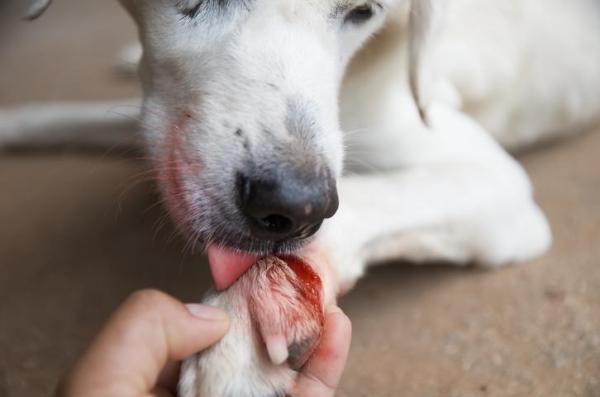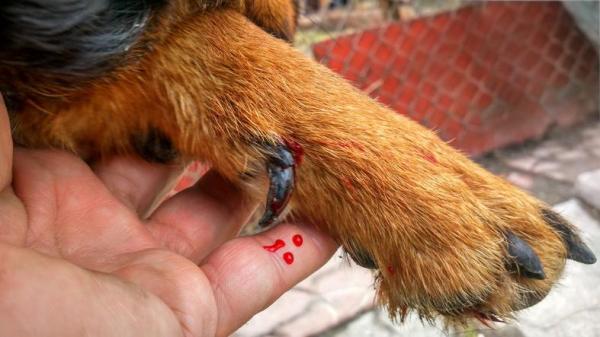Is Chlorhexidine for Dogs Safe?



See files for Dogs
A suitable first aid kit for dogs is recommended for all dog guardians. When it comes to dog wounds, their adventurous and often energetic nature means they can get in trouble easily. Whether they run over something sharp or get on the wrong side of an aggressive animal, accidents happen. Knowing the best way to treat a wound is imperative. There are various disinfectants we use on humans, but they may not always be safe for dogs. One common disinfectant we use is chlorhexidine. It is available in various forms including wipes, spray and solution.
In this article, AnimalWised asks is chlorhexidine safe for dogs? We look at how a dog's wound should be disinfected and what type of chorhexidine might be best used.
What is chlorhexidine for dogs?
Also known as chlorhexidine gluconate (CHG), chlorhexidine is both an antiseptic and disinfectant which has various uses. It is on the WHO's ‘List of Essential Medicines’. These are medicines and medical products which are both the safest and most effective to use for treating human health problems. Many of them are able to be used on dogs also, but many are not.
We can never assume something which works for humans will be effective for dogs. In fact, many products which are safe for people can be toxic for dogs. Also, dosage and administration are not the same for both. As a disinfectant, chlorhexidine can be bought over the counter. It is sold under various brand names including Betasept, Spectrum-4, Calgon Vesta and others. It is similar to Betadine (povidone-iodine) and may even be slightly more effective.
Can chlorhexidine be used for dogs?
Chlorhexidine is safe to use on dogs. It can be used in the same way as many other disinfectants, such as the aforementioned Betadine. We can use it without first consulting a veterinarian, but one should be contacted if there is any doubt. This is if the wound is minor and treatable at home. If our dog suffers a severe injury, then they need to be taken to an emergency veterinary clinic. Blood loss, infection and poor healing are some of the complications which can arise without appropriate treatment.
Not only is chlorhexidine for dogs safe, it should not sting them when applied. It acts as a barrier to bacteria, so a dog with a wound can be cleaned using chlorhexidine. It can also protect against fungal infection, although generally to a lesser extent. Depending on the concentration, chlorhexidine can have either a bactericidal or bacteriostatic effect. In the former, bacteria will be killed. In the latter, it only works in limiting their growth.
Is chlorhexidine safe for dogs' ears?
While chlorhexidine may be used for treating wounds on a dog's ear, we need to be careful. Chlorhexidine is potentially ototoxic, meaning it can damage the ear. The outside of the dog's ear will be fine, but if it is introduced to the ear canal, it may damage the vestibular system. This is particularly the case if the ear drum is already perforated. Do not introduce chlorhexidine into the ear canal unless directly prescribed by the veterinarian.
Chlorhexidine for dogs uses
Chlorhexidine is mostly used for dog wounds or superficial burns. At home, over the counter chlorhexidine can be used to disinfect small cuts and skin breakages. In veterinary medicine, chlorhexidine is also used to wash surgical instruments and prepare incision sites for surgery. Deep wounds and extensive lesions need to be assessed by a veterinarian, so do not try to treat it yourself beyond administering first aid.
However, uses of chlorhexidine for dogs are not limited to treating skin lesions and wounds. Chlorhexidine is also safe to use in oral administration. If the dog has a cut on their gums or oral mucous membranes, a solution may be used for disinfecting the problem. It has also been used as a preventive in chew toys for dogs to help stop gum disease developing[1].
The concentration of chlorhexidine for dogs will impact its safety. One solution may be safe to us eon a dog's skin wound, but may not be safe if administered orally. Additionally, we need to be safe when using chlorhexidine near a dog's eyes. It has the potential to be harmful to the cornea, so we need to be careful when using it in this area. Additionally, some dogs may find it irritating on their skin, so a different disinfectant is needed.
Types of chlorhexidine for dogs
As we said above, chlorhexidine comes in different preparations. They include:
- Wipes: medicated wipes have chlorhexidine in them which can be used on the skin. Be careful not to further damage a wound if using on a dog's injury.
- Spray: this is a handy form of chlorhexidine which can be prayed directly onto the wound site. Not to be used orally.
- Solution: this preparation is a diluted form of chlorhexidine, but the concentration of each solution can differ.

How to disinfect a dog's wound with chlorhexidine
We stress again that chlorhexidine should only be used on superficial or small wounds which can be treated at home. If this is the case, we can use the following guidelines:
- Trim the fur: by trimming the hair around a wound site we can better observe the wound and clean it better. A dog's hair can also encourage bacteria to grow, so it is a better way to prevent contamination. We can perform this action using scissors.
- Irrigate the wound: using clean water or saline solution, irrigating the wound helps to remove dirt and debris without causing more physical trauma to the wound site. We should also ensure to wear latex gloves to prevent more dirt, bacteria or anything else contaminating the wound.
- Clean with gauze: once irrigated, we can clean the wound site with gauze, again being careful not to further damage the skin.
- Apply chlorhexidine: whether using a solution or spray, we can soak the gauze in chlorhexidine and apply it gently to the wound. If using a chlorhexidine wipe, this is done for us. No more than 2 applications of chlorhexidine per day is recommended.
Once the chlorhexidine has been applied, we do not cover the wound., On the contrary, we need to let it be exposed to the air. This aid sin healing and also helps us to see its progress. We need to be careful the dog does not bite or lick the wound as this can cause contamination and prevent healing. We may need to use an Elizabethan collar to stop this from happening.
If we see that chlorhexidine is not enough and the wound does not heal or becomes infected, we need to seek veterinary advice immediately. Pus, discoloration and other signs can show us a dog's wound is not healing properly.

This article is purely informative. AnimalWised does not have the authority to prescribe any veterinary treatment or create a diagnosis. We invite you to take your pet to the veterinarian if they are suffering from any condition or pain.
If you want to read similar articles to Is Chlorhexidine for Dogs Safe?, we recommend you visit our Medicine category.
1. Rawlings, J. M, Gorrel, C., & Markwell, P. J. (1998). Effect on Canine Chlorhexidine to a Dental Hygiene Chew. J V Dent, 15 (3), 129-34.
https://www.ncbi.nlm.nih.gov/pubmed/10597158







